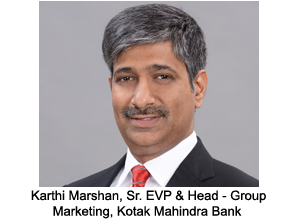Home » Viewpoints » 'OOH is ideal for hyper-localising campaigns'
'OOH is ideal for hyper-localising campaigns'
By M4G Bureau - June 01, 2015
Kotak Mahindra Bank, one of the largest private banks in the country, runs highly innovative outdoor advertising campaigns to connect with its target audience. The bank leverages the OOH medium to effectively localise its messaging to consumers. Karthi Marshan, Sr. EVP & Head - Group Marketing, Kotak Mahindra Bank, talks about the bank's approach to OOH advertising in conversation with Rajiv Raghunath of Outdoor Asia. Edited excerpts:
 What are your expectations from OOH advertising? How does it contribute to your bank's overall brand building efforts?
What are your expectations from OOH advertising? How does it contribute to your bank's overall brand building efforts?We see OOH advertising as a physical extension of our brand footprint. It is impactful when executed in the vicinity of our branches.
Do you prefer traditional OOH formats for your campaigns, such as, billboards, bus shelters and the like, or do you also use digital OOH for your campaigns?
We prefer the traditional formats for our outdoor advertising. While we have done some experiments with digital OOH, our assessment is that if we want to go on the small screen, we would rather be on people's personal computers or handheld devices. That is arguably easier and cheaper to reach.
Do you consider OOH advertising to reach out to consumers in non-Metro markets?
Absolutely yes. OOH enables personalisation and localisation of the messaging. The added advantage of OOH is that it helps to actualise the messaging around my catchment area. Print is another good way to localise messaging but it can be expensive.
To explain this, if I draw circles around my branches, I can localise the messaging for each of the circles and engage with customers more meaningfully.
Through OOH we are also able to localise the messaging in terms of language. For instance, in Vijayanagram I can use the particular dialect of Telugu prevalent in that city for my messaging. If it is Hyderabad, I can do the messaging in the dialect prevalent there. This is what we achieved through our recent'Kona Kona Kotak' campaign. We hyper-localised the campaign.
There are other unique things that we have achieved through our OOH campaigns. For instance, we use the geographic benefits. For example, we drew circles around our branches and used the bus shelters and billboards falling within the circles as way-finders to our branches. Hence, we could go with a messaging like'You can get 6% just 300 meters from here'.
This approach helps us create a local connect as opposed to a 30,000 feet brand message.
Contextualising messaging for the customer at the hyper-local level certainly helps create an emotional connect.
What steps do you suggest for your brand to stand out on the OOH landscape, especially in the midst of competing brands?
Rule number 1: the messaging has to be concise, lucid and single-minded. We have a thumbrule that the headline should not be more than six words. Sometimes, however, we do use 7-8 words as an exception.
Rule number 2: OOH can do one job at a time, so don't make it do five jobs at a go. Clients are always tempted to do that. In our'Kona Kona Kotak' campaign, the creatives had large white space, a dream for any creative person. There was very little messaging and just one striking visual.
I might add that we have also started humanising our OOH much more.
We use brand attribution metrics to check the effectiveness of our campaigns. We believe we have done our job only if a significant number of respondents (in our survey on outdoor advertising) identify our campaigns and associate the same with our brand. To that effect, we ran one of our 6% campaigns without using our logo. The creative only featured the messaging'6%' and'Subbu' -- our mascot. We surveyed the consumer response and found the brand attribution was very high. It was a bold experiment. We did the same on TV. We wanted to see whether the'6%' messaging was effectively serving as a proxy for our brand.
It's like this. If you see the'swoosh' you will immediately attribute it to Nike. Likewise, we wanted to see how our messaging makes consumers think of our brand.
Please share your thoughts on your recent campaign following the merger of ING Vysya bank with Kotak Mahindra Bank? Have you assessed the impact of the campaign in terms of consumer awareness of the merger?
Yes, we did. In fact, we have a monthly track that we run with Nielsen, which focuses on customer mind metrics for my brand. Whenever a new campaign is launched, we place ad diagnostics on top of it. We test the level of visibility, what percentage of my target audience has seen the ad, how many recall the brand name in the ad, what percentage liked what they saw, etc. We also check the'wear out' effect, that is, whether I am bombarding consumers with my messaging.
The results that we get from OOH advertising are comparable with the results from other forms of advertising. But I am not sure if OOH can stand on its own. It is a powerful reminder medium.
Would you advocate OOH-specific creatives for OOH advertising?
We take that approach for all our advertising cutting across mediums. Our messaging may be uniform but the expressions on different mediums are necessarily different. When we launched'Kona Kona Kotak', we ran a print ad for a day covering the entire market, whereas the messaging was localised through OOH. In every town that we are present, we carry a creative that is relevant to that city or town.
Transit media is a preferred media for many advertising brands. Do you opt for transit media for your OOH campaigns - including airport media and Metro media?
We target the middle class and upper middle class segments. When we look at transit media, we filter the opportunities basis our target audience. Airport media is one effective medium. High-end cineplexes are another. We have done a few campaigns around the Metro, but not a lot. Broadly we focus upon the large formats.
How important are onground activities for a brand like yours?
On-ground activities are an important component to the entire media mix of a campaign. To illustrate this, some time ago we ran a TV campaign of our product - Kotak Junior, designed for kids. That year, all our on-ground activities were centred around kids.
What changes would you like to see in the OOH space such that OOH advertising delivers greater value to your brand?
I would like to see the use of neutral monitoring and measurement metrics. I would want to know how a particular billboard delivers better than another in its vicinity. I want to decide which billboard or bus shelter to opt for basis data on outdoor advertising.

Stay on top of OOH media trends
Advertisement







